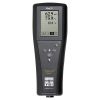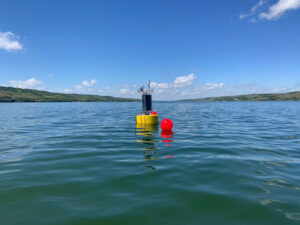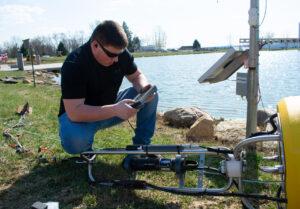Thermo Orion Star A223 Portable RDO/DO Meter
Features
- Displays DO concentration, DO percent saturation and temperature readings
- AUTO-READ function alerts user and locks stable readings on backlit LCD screen
- USB and RS-232 ports allow easy data transfer of up to 1000 time-stamped data points
- Free ground shipping
- Expedited repair and warranty service
- Lifetime technical support
- More
Overview
The waterproof, battery-operated Thermo Orion Star A223 portable RDO/DO meter stands up to the most demanding field applications and delivers over 800 hours of continuous operation. The backlit display shows DO concentration, DO percent saturation and temperature readings along with time, date, sample ID, user ID and calibration information. The meter accepts both Orion polarographic probes and RDO optical probes for increased accuracy and versatility. For advanced users, features such as stability and averaging choices provide additional options.
Data Storage
The Thermo Orion Star A220 series benchtop meters provide a large storage capacity for time-stamped data points, which can be conveniently uploaded to a PC through the meter's USB and RS-232 ports. Complimentary data analysis software allows users to quickly view and manipulate data. Accuracy can be ensured through a variety of pressure compensation options and calibration methods.
Benefits
- Automatic temperature compensation, manual salinity compensation and automatic or manual barometric pressure compensation
- Calibration options include water-saturated air, air-saturated water, Winkler titration and zero point
- Non-volatile memory holds up to 1000 data points
- Electrode arm and newly-designed probe holder to place probes into samples
- Universal power supply or battery power option
- USB and RS-232 ports to upload data and update included data analysis software
- Multilanguage interface supports English, Spanish, French, Italian, German and Chinese
- IP67-rated housing (may be immersed for up to one hour with no water incursion)
- 3 year meter warranty
- Dissolved Oxygen Polarographic Concentration (% Sat)
- Range: 0 to 90 mg/L (0 to 600 %)
- Resolution: 0.01, 0.1 (0.1,1)
- Relative Accuracy: +/-0.2 (+/-2 %)
- Dissolved Oxygen RDO Concentration (% Sat)
- Range: 0 to 50 mg/L (0 to 500 %)
- Resolution: 0.01, 0.1 (0.1,1)
- Relative Accuracy: +/-0.1 up to 8 mg/L;+/-0.2 from 8 to 20 mg/L; 10% of reading above 20 mg/L(+/-2 %)
- Dissolved Oxygen
- Manual Barometric Pressure Compensation: 450.0 to 850.0 mm Hg
- Manual Salinity Factor Correction: 0 to 45 ppt
- Calibration Features: Water-saturated air, air-saturated water, manual (Winkler) and zero point
- Sensor type: Polarographic or RDO
- Temperature
- Range: 0 to 50 C
- Resolution: 0.1
- Relative Accuracy: +/-0.1 C
- Offset Calibration: 1 point
- Datalogging
- Number of Points: 1000 with time and date stamp
- Log Function: Manual, Automatic with AUTO-READ
- Log Edit: Delete individual points, group of points or all
- General
- Display: Backlit LCD
- Inputs: 9-pin mini-DIN
- Output: RS-232, USB
- Power Adapter: Universal AC, 100-240 VAC
- Battery Power: 4 AAs, 800 hrs life
- Environmental Requirements: 5 to 45 C and 5 to 85% relative humidity, non-condensing
- Regulatory and Safety: CE, TUV 3-1, FCC Class A
- IP Rating: IP67, waterproof
- Warranty: 36 months (from date of purchase)
In The News
Choosing The Right Thermo Portable For Your Project
With so many options in Thermo Scientific’s Orion Star A line, it can be difficult to narrow down which meter will best fulfill a project’s needs. One easy way to rule out some meters is by considering application type. For projects that rely largely on collecting samples in the field, a portable meter is clearly the way to go. But there’s still a handful of meters to choose from. To simplify making the right choice, we spoke with Ricki Hartwell, the global product manager for Thermo Scientific’s Orion Laboratory and Field Instruments. She recently shared her tips on choosing the right Thermo benchtop. Let’s take a look at her recommendations for selecting the right portable meter.
Read MoreCombating Water Insecurity in Saskatchewan with Real-Time Data
The prairies of Saskatchewan can be described as one of the least water-secure parts of Canada, making water quality monitoring essential for informed resource management in a region already facing water insecurity. While natural physical properties worsen some of the poor water quality conditions in the region, others are connected to land use. Having grown up spending summers on the shores of Lake Huron, Helen Baulch, an associate professor at the School of Environment and Sustainability at the University of Saskatchewan , has always been dedicated to the protection of water resources. Looking back fondly at her childhood playing along the shore, Baulch also recalls the invasion of quagga mussels during her teenage years and watching the lake change as a result.
Read MoreSeametrics Turbo Turbidity Logger: Boost your Turbidity Monitoring
The Seametrics Turbo Turbidity Logger is a self-cleaning turbidity sensor capable of internally logging over 260,000 data records. The sensor enables researchers, compliance officers, and contractors to monitor turbidity in various applications, from construction and dredging sites to wastewater effluent. Due to its narrow width, this device can be deployed in a range of areas, from small well spaces to rivers and streams. The stainless steel housing and built-in wiper allow the sensor to withstand long-term deployments and reduce the need for maintenance trips. The logger accurately records temperature and turbidity up to a depth of 50 meters.
Read More






















